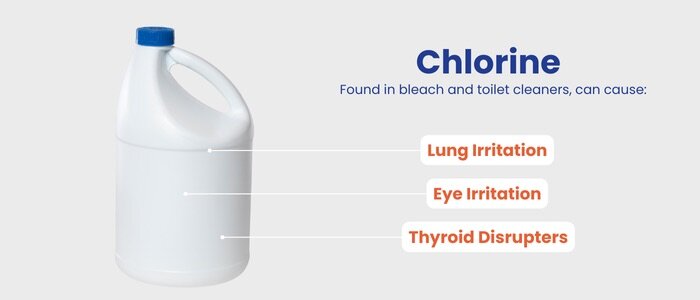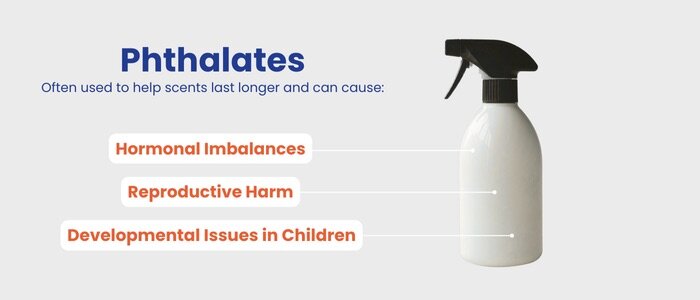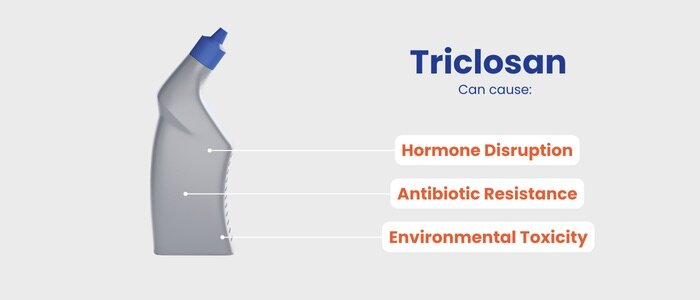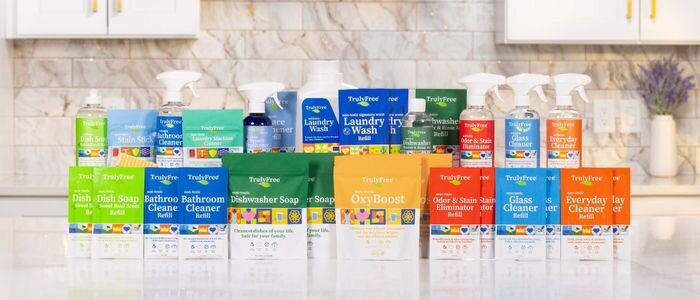- Shop
- Learn

Posted By: Truly Free Home
|
Posted On: 4/23/2025
Ever flip a bottle of cleaner over to read the label and wonder…. Are those ingredients safe to use around my family? What about my pets?
This question is worth asking. It’s shocking how many grocery-store cleaners are loaded with scary chemicals—chemicals that can make your family sick.
Whether you’ve just started to live a low-tox lifestyle or have been keeping a non-toxic home since before it was cool, reading those labels is the key to knowing which chemical ingredients to avoid in cleaning products.
Keep this list of cleaning product chemicals to avoid handy to understand how to shop for safe cleaning products for your home.
Because 1,4-dioxane—a known carcinogen—is a byproduct of certain manufacturing processes, it won't be listed on product labels. Instead look for ethoxylated (produced by the ethoxylation process) ingredients with suffixes like "-eth", "PEG", "polyethylene", "polyethylene glycol", or "polyoxyethylene.”
Often found in glass and window cleaners, ammonia can cause irritation to the eyes, respiratory tract, and skin. It also releases fumes that can be especially harmful to children and people with asthma.
Used as a disinfectant in bleach and toilet cleaners, chlorine can irritate the lungs and eyes. Long-term exposure may disrupt thyroid function and increase health risks.

This chemical is used to preserve products and prevent bacteria growth. It is a known carcinogen and can trigger asthma, skin irritation, and allergic reactions. Synonyms include: formalin, formic aldehyde, methanal, methyl aldehyde, methylene glycol, and methylene oxide.
The term “fragrance” may sound harmless but companies are allowed to hide hundreds of toxic chemicals behind this one word because of the fragrance loophole. Toxic chemical fragrances are linked to hormone disruption and allergic reactions.
Often used to help scents last longer, phthalates are linked to hormonal imbalances, reproductive harm, and developmental issues in children. Look for acronyms like DBP (Dibutyl phthalate), DEP (Diethyl phthalate), and DEHP (Di-(2-ethylhexyl) phthalate) on the ingredient list.

A foaming agent found in many soaps and shampoos, SLS can cause skin irritation and may be contaminated with 1,4-dioxane. Look for synonyms such as Lauryl sodium sulphate, Lauryl sulphate sodium salt, Sodium dodecyl sulphate, or Sodium n-dodecyl sulphate.
A common ingredient in disinfectants, bleach releases toxic fumes, especially when mixed with other cleaners like ammonia. On its own it can cause severe respiratory problems, eye irritation, and skin burns.
Found in disinfectants and fabric softeners, quats are skin irritants and may contribute to antibiotic resistance. Look for ammonium chloride or quaternary ammonium or common QACs such as Benzalkonium Chloride (BAC or BKC) and Didecyldimethylammonium chloride (DDAC).
Products labeled “antibacterial,” or make claims such as “odor-fighting” or “keeps food fresher, longer,” often include triclosan. Triclosan has been linked to hormone disruption, antibiotic resistance, and environmental toxicity.

Creating a non-toxic home doesn’t happen overnight, but every small swap makes a difference. Start by checking the labels of your current cleaners, and begin replacing them one by one with trusted non-toxic products like what we offer at Truly Free Home.


Truly Free Home is a non-toxic home cleaning and laundry product brand on a mission to free over 10 million homes from harmful toxic chemicals and excessive plastic waste.